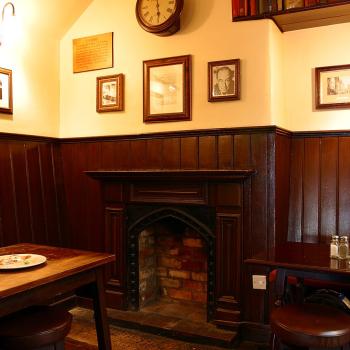Like the Shaman, Santa embodies magic and mystery, the spirit of nature as well as universal human values of caring and generosity. The word "Shaman" is a Siberian word and Siberia is the land of the reindeer. In his Primitive Mythology, Joseph Campbell describes a legendary Shaman who received his enlightenment in the nest of a winged reindeer in a tree, which was thought to reach the heavens.
There were also Goddesses who rode sleighs and delivered gifts. The Norse goddess Freya rode a chariot pulled by stags.
The life and legends of the Christian St. Nickolas continue the magic of the Shaman. As a young man St. Nickolas traveled to the holy land and on his way back was blown around in a storm and ended upon the coast of Lyca near Myra. He went to pray at the nearest church, where the bishop was retiring. One member of the convocation (committee) to choose a new Bishop had had a vision that the new Bishop would be coming to the church and his name would be Nickolas. Arriving as he did the boy was made Bishop of Myra.
After serving a prison term under the Romans, young St. Nickolas participated in the decision of Pope Liberus to make December 25 the official date of the birth of Christ and the celebration of Christmas. He was a generous man who gave much to the poor of Myca throughout the year but especially around Christmas. He was also a Christian Shaman whose miracles that lead to his sainthood included bringing back to life three boys who had been chopped up and boiled in a pot for stealing.
Modern Santas. Our modern image of Santa in a red suit can be traced to Thomas Nast, an amazing commercial artist of the 19th century. He developed Santa for President Lincoln as well as the Donkey and Elephant of the Democrats and Republicans. His illustration was used in a New Yorker publication of Clement Moore's famous poem, "T'was the Night before Christmas."
Even today the image of Santa grows and expands to fill hopes and dreams of all children. Modern Santas of all races and nationalities join woodland and other artist Santas to adorn homes and businesses. Woodland Santas stand on store shelves beside Santas who play golf, surf, and just about any activity you can imagine. Some even have electronic movement and sound.
Evergreens. The obvious symbols of eternal life, green when all else is barren and brown, evergreens were probably held sacred very early in human prehistory. Again, the palm fronds in Egypt and the greening during the Kalends are recorded examples.
The Christmas tree. It is said that in the 6th century the Christian St. Boniface cut down a sacred oak to spite local druids. As the tree fell, it crushed everything in its path except one cedar. He declared it a miracle and that the tree belonged to the Christ child. This is often cited as an example of cultural assimilation of Pagan religious symbology for political purposes.
Hanging of the greens. Decorating with evergreens was first noted in Egypt. It was also popular during the Roman Saturnalia and Kalends. The Norse also brought in evergreens for decoration during the long snowy winters. Where Christmas is celebrated, the evergreens are often used to mark the start of the season, which is longer than that of any of the preceding cultures, now beginning shortly after Halloween and withering out sometime in mid-January, marked mainly by clearance sales.
Holly. A symbol from the Celts, the male symbol of rebirth is again an evergreen, this time with red berries. A plant of protection, holly is the symbol of the god of the dark year.
Mistletoe. Mistletoe may have first been used in the Greek winter ceremonies. The Norse legend said it was blessed with luck and fertility by the goddess Frigga after Balder, her son, was shot by Loki, the dark and mischievous imp god, with an arrow of mistletoe. Her tears restored him to life and fell also on the mistletoe giving it magical properties. Mistletoe was also sacred to the Druids. As it dried, it became the golden bough, symbolic of both sun and moon, of the male and female mysteries.
Winged Goddesses, Angels, and Elves. These range from representations of the Goddess Iris to the Catholic angels. From the many spirits of the holy host to Santa's magical elves, these winged fairies bring another element of the mischievous imps to our Solstice season.
Madonna. The female remains firmly in the season, firmly eternal throughout the turning of the wheel, the force of nature herself. Her consort, son, partner going through continual birth and rebirth is the wonder child.
Yule log. This harks back to the importance of fire during the darkness of winter. A whole tree was burned during the Greek festival of Sacaea to scare away the Kallikantzuroi (mischievous imps). The familiar Yule log was a Norse tradition adopted by the Christians. In early America there was a custom "freedom of the Yule," a week off for slaves and servants while the Yule log burned. "Firewood as wet as a Yule log" was a saying that this custom generated.




